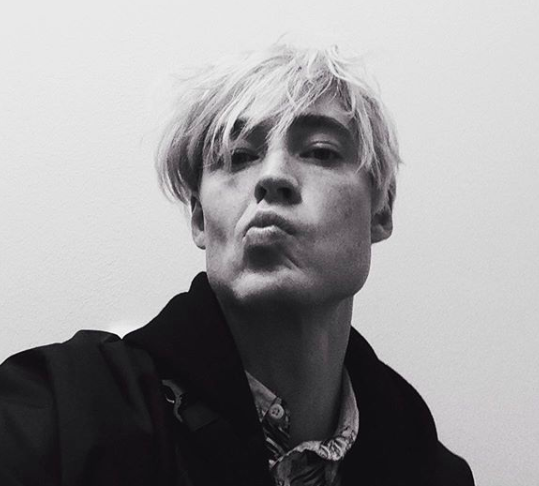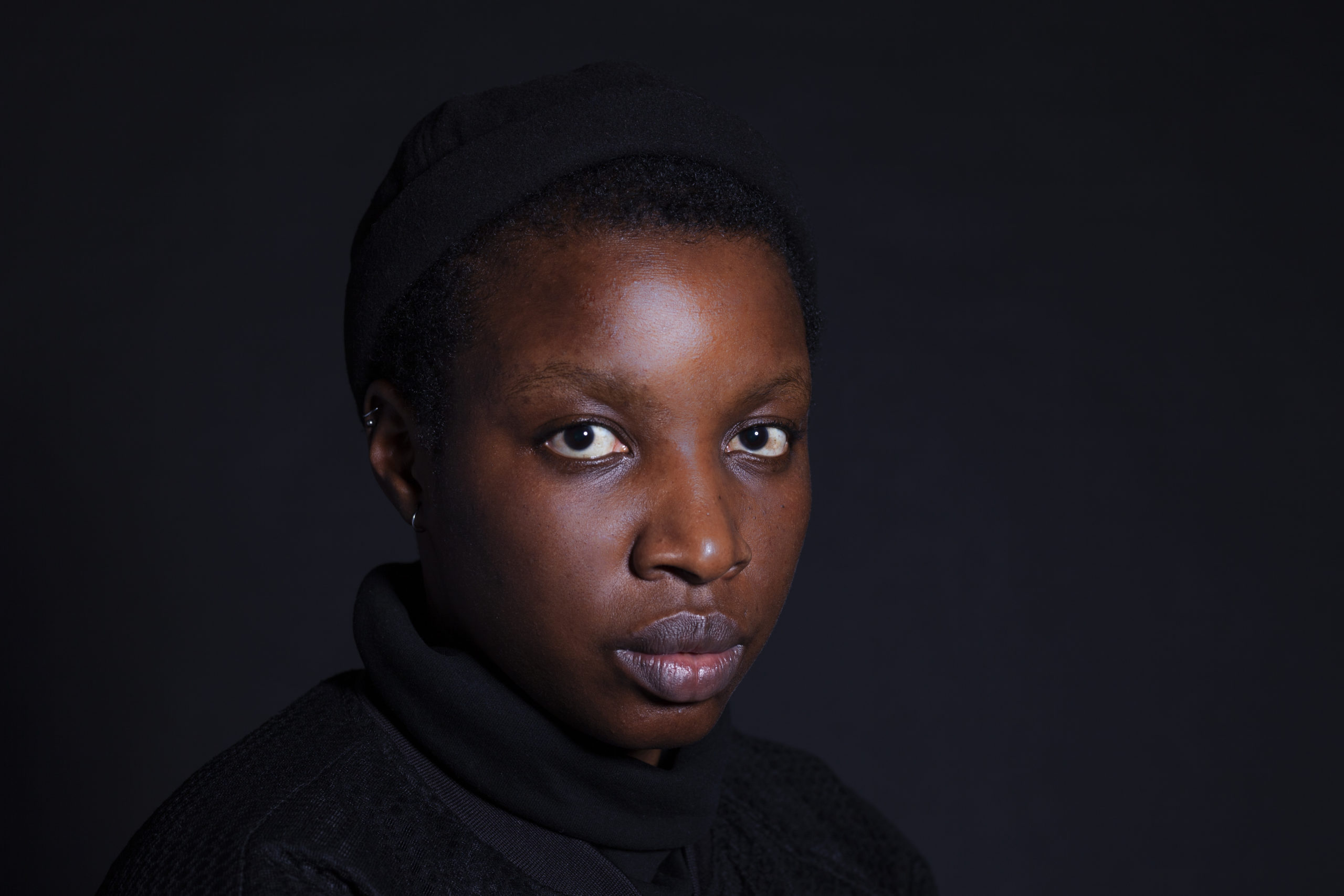“To Me, Everything is a Space for Encounter”: Michael Laundry in Conversation with Belinda Kazeem-Kamiński
Belinda Kazeem-Kamiński is an interdisciplinary artist mainly using archival and museal material for artistic research in photography and video. Late last year, Kazeem-Kamiński received the Camera Austria Award for Contemporary Photography by the City of Graz. A solo show of her work was also recently on view at Kunsthalle Wien. While in Vienna, Michael Laundry spoke with Kazeem-Kamiński about how her work creates space to think about Black feminism, representation, and post-colonial theory. In this interview, Laundry and Kazeem-Kamiński discuss the her use of slide shows, artist books, photography, and video in the dissection of the white gaze on Black bodies, and her reimagining of the archives as a space of encounter.
Michael Laundry: Your practice is interdisciplinary: you work with video, photography, and text-based practices. Can you talk about the strategies you use to integrate these elements?
Belinda Kazeem-Kamiński: My projects often start with European archival photographs. When working with these sources, I aim at both reflecting the inherent white gaze and developing narratives that take so-called others, mostly non-Western people, seriously as subjects. I counter the archival material and think about possibilities of developing an oppositional gaze. The latter is the foundation for sharing stories that are usually silenced. Often what I come up with deliberately stays fragmentary, but still I consider these narrations to be important when thinking about present needs and the possibilities of political imagination. Having studied European museal representations and displays, I often play with these forms of representation and the affects they produce, as a way of disrupting what is normalized. In recent years, I have been shifting away from writing as my primary medium, towards visual arts and filmmaking. The recent exhibition at the Kunsthalle Wien was my first solo exhibition: the oldest work shown was from 2015, the newer ones are from 2021.
ML: You work with history and historiography particularly as it relates to how we see colonialism today in Europe. How or why did you go there?
BKK: If you’re interested in how the specific structures of domination, racism, heterosexism, and ableism, for example, came to be in the world today, eventually you start looking to history with the hope of explanations. In my case, I wanted to understand how representations of Blackness in Europe, or the West came to be, and how specific ways of looking at Black people have been normalized. Soon enough, I realized that trying to understand racism on an individual level couldn’t address these issues. Racism and discrimination are not caused by an individual’s personality: there is something bigger than individual experience—we could call it a structure that allows discrimination to happen again and again. That’s what I became interested in: white supremacy as a structure, the various ways that whiteness is being normalized, and the ways other forms of discrimination intersect with it.
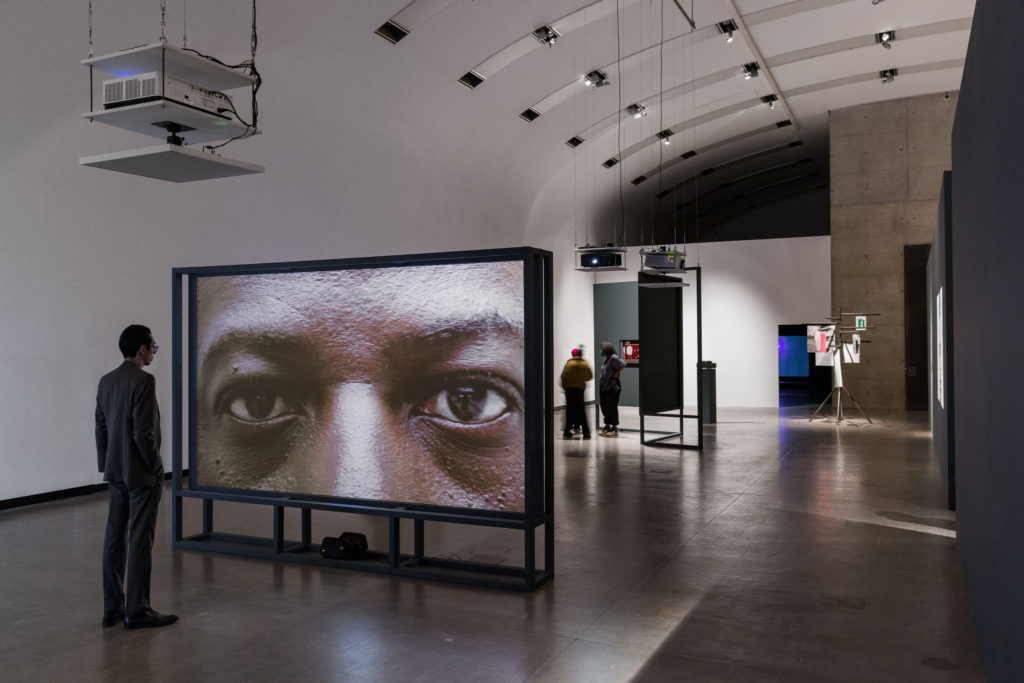
Belinda Kazeem-Kamiński. Installation view (Fleshbacks, 2021), Kunsthalle Wien, Vienna, 2021. Photograph by www.kunst-dokumentation.com
ML: The exhibition at the Kunsthalle Wien was installed so that the video installations face one another and thereby create a dialogue. This conversational or dialogic element seems important to your work, which also often focuses on encounters with people and objects that have disappeared from either historical archives or public debate.
BKK: I think of my artistic process as a way of opening up and creating space for conversation. I use performance, conversations, images, and films in order to generate that space. I am not a historian, so I do not feel obliged to only state what I can prove with documents and data. Moreso, I am inspired and interested by a question like “What if?,” which allows me to imagine and thereby emphasize connections that I consider to be important. I am trying to help the audience—and myself—think about the effects of a past that is not yet over, despite the fact that some of us are able to ignore it, to consider it to be truly past. What becomes obvious is that people enter these spaces with different desires, knowledge, and opinions. Some people might feel affirmed, while others might question their relation to coloniality or to the enslavement of African people. Oftentimes this creates tensions—I am not talking about conflict, but rather the tension you feel when you are challenged. This is not negative per sé. I consider tension and being challenged to be productive, in the sense that you walk away and at best something has happened between you and the artwork, or between you and fellow viewers of a exhibition. I am also challenging myself here.
Look at Unearthing. In Conversation (2017) for example, the video in which I take the Austro-Czech missionary and ethnographer Paul Schebesta’s (1887-1967) photographs as a starting point to negotiate the haunting effects of colonial violence on the here and now. In the video you see a performance—I developed the video after I performed the piece twice. The performance text is analytic, but it is also deeply personal. And I had to go through this performance and the challenge it posed to me, in order to truly understand what was asked from me, encountering parts of myself I had not been aware of before.
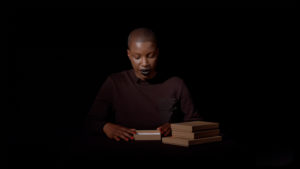
Belinda Kazeem-Kamiński, Unearthing. In Conversation, 2017. Video (still). Photograph by the artist.
ML: You have a rich background in gender studies, critical theory, and museology, and you have worked with the Black Women’s Community in Vienna. How do these experiences shape your practice as an artist-activist working with Black feminism?
BKK: The Black Women’s Community in Vienna is actually where I was politicized. It is a self-organized association, made up of Black women who organize for other Black women, kids, and youth. Once I began working there, I started to understand that there was something terribly wrong with our world and how we think about people that we perceive as other. My experiences with this organization helped me see racism as something that is embedded in society on a structural level.
ML: And then that informed your academic work?

Belinda Kazeem-Kamiński, Unearthing. In Conversation, 2017. Video (still). Photograph by the artist.
BKK: Yes. It started to inform my academic work, because I had decided to go to university at the same time. I decided to focus on Black feminism, on representation, museology, and post-colonial theories. It was through the Black Women’s Community and associated people that I got to know writers and thinkers like bell hooks, Audrey Lorde, and May Ayim. My early practice was very much inspired by Black feminist writers, artists, and thinkers. It still is, especially by the ones dealing with topics such as the gaze, the afterlives of colonialism and enslavement, and the spectacularization of Blackness. Christina Sharpe’s book In the Wake: On Blackness and Being (2016) had an immense impact on my thinking, for example, through her concepts of Black redaction and Black annotation as visual strategies. Encountering her writing after having finished Unearthing. In Conversation (2017) made me feel like I had finally found words for what I was trying to do. In this respect, I also want to mention Tina Campt’s Listening to Images (2017). Both books are amazing resources, and somehow confirmed what I am trying to get at via my artistic practice—namely, finding ways of dealing with the past without once again objecting the ones who have been objected in the first place. I think this is something I took away from reading someone like May Ayim, a Black German writer. Her poems and writings have been a lifeline for me: the ways in which she found language for what is so often silenced. Of course, there are also many artistic inspirations, artists like Rotimi Fani-Kayode, Carrie Mae Weems, María Magdalena Campos-Pons, performers like Ligia Lewis or Koleka Putoma, and filmmakers like John Akomfrah and Cheryl Dunye. I could name many more; I guess what unites all of these people is their rigourous investigation of whiteness and power, through visual strategies that challenge its normalization. I am fiercely committed to looking beyond, towards spaces for which we still might not have found names but which are nonetheless oriented towards Black freedom.
ML: In Fleshbacks (2021), a three-part single channel video, you have conceptualized these short films as filmic annotation. The three scenes act as annotations to a historic event, namely the exhibition of a group of West African performers that where on display in Vienna in 1896-97. Your artistic practice calls into question the objectification of Black bodies through orchestrating a shift of the white gaze on Black bodies. In other words, you apply various visual strategies to choreograph a response to the voyeuristic gaze. One one hand, your work prompts the viewer to reconsider who controls so-called scopic regimes by inhibiting a voyersitic gaze. On the other, you ask the viewer to appropriate the gaze providing alternative subjects. Could you describe how the gaze and the exploration of scopic regimes function in your work?
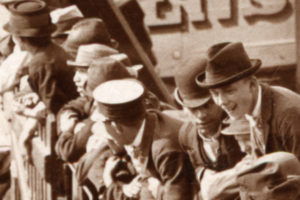
Belinda Kazeem-Kamiński, You are awaited, but never as equals, 2021. Diashow (26 black-and-white slides). Photograph by the artist.
BKK: My strategy has always been to find ways to avoid repeating violent scopic regimes. Still, what I am interested in doing is highlighting these regimes, and thereby stripping them of their assumed neutrality. In many of my works, I make these tiny little shifts: I block something or cut it out, thereby only allowing you to look at the work in a specific way. By doing so, I hope to make visible what is all too often an unspoken norm: whiteness. Consider You are awaited, but never as equals (2021) for example. The initial material I worked with were five black and white photographs taken by a photographer who captured the scene of the arrival of the West African performers in 1896 in Vienna. One of these photos was also turned into an official postcard. In You are awaited, but never as equals (2021) I zoom in on specific details of the photographs, and present these new images in the setting of a slide projection. I was particularly interested in analyzing how the joy and delight in the spectacularization of the African body becomes visible in the body language of the Viennese viewers: their facial expressions and gestures. Their looks, finger-pointing, and staring are very contemporary.
ML: You often humanize subjects who have been subjected to a colonial gaze, while also pointing out racialized views today. You also emphasize the voices of women who—previously—may have only been given a voice through white European men. This happens, for example, in your Yaarborley Domeïs Brief (2021) (engl. Yaarborley Domeï’s Letter), an artistic insert in the newspaper Der Standard. This work republishes an open letter from 1996, putting the work into dialogue with today’s context. Who was Yaarborley Domeï?
BKK: Yaarborley Domeï was a female member of the aforementioned group of West African performers. I like to call them performers because that’s what they did: they performed. It’s not like they were being themselves, like the Viennese audience would like to think. They performed what the Viennese audience equated with African life. They were exhibited in the Wiener Prater, an amusement park. The organizers built houses, resembling what Europeans considered to be African houses. The visitors could walk through the whole area. There was a school, a kitchen, there were all sorts of things. These kinds of venues have existed all over Europe and also in the US. This specific display stayed in the memory of the city. When I visited exhibitions on other topics in Vienna, I would repeatedly encounter photographs of this group. I heard about the show for the first time when I was 26. I was quite shocked and immediately went to the library, to borrow a book by an Austrian writer, Peter Altenberg. He apparently was an avid visitor of the show. In 1897, he published a book called Ashantee (Peter Altenberg, Ashantee (Berlin: Fischer, 1897).) in which he shared his experiences with the performers. I was very troubled by it. I can finally say this, after having really worked through the experience of it.
ML: Could you share more about your practice of intervening and editing as a textual practice, in this book and in general?

Belinda Kazeem-Kamiński, Ashantee, 2021. Artist book. Edited by David Avazzadeh. Photograph by David Avazzadeh.
BKK: In the case of this book, I started by deleting and erasing parts of Altenberg’s writing. First with a black marker, but then I would scratch the letters out. In the end, I decided to make an artist’s book titled Ashantee, edited (2021). From the outside, it resembles the original book, but when you open it, there are only some words left from the original text. I only left the words and names of people that were guiding me in my research, everything else had to go. Funny enough, it seems that I was only able to become aware of some details—like the performers’ addresses—once Altenberg’s “chatter” was cleared away from the text.
Shortly after I had completed the dummy of the artist book, I stumbled across the letter that Yaarborley Domeï wrote. Many things that are said about these displays are informed by sources of white men: journalists, ethnographers, and authors like Peter Altenberg. Instead, I decided to follow Yaarborley Domeï’s letter. It was an open letter for a Viennese newspaper, the Wiener Caricaturen, in which she speaks about the circumstances of the display. She is very outspoken. Apparently, she wrote the letter in Ga and her partner translated it to English. And then it was translated to German. So it’s a translation of a translation. Still, it is insightful: insightful for me, or for others who would relate to her experience, but also for a bigger contemporary audience here in Europe.
ML: A bigger audience, what do you mean?
BKK: What I find interesting is that even though this is long before intersectionality was established as a framework, you can see this way of thinking is very inherent in her analysis of the whole situation. She speaks about the way that people look at the performers, the way they want to touch them and demean them. But on the other hand, people are also apparently envious and pulled to the performers, and they desire to be close to this group. So I think that Yaarborley Domeï’s letter is a very sharp analysis of the situation. And she’s very outspoken. For example, the first sentence says: these white people are stupid. Here they are looking at us. I mean, I’m just paraphrasing. Here they are looking at us, how we peel potatoes, how we do this, how we do that. But, if they would come to Accra, none of us would pay a dime to see this. It underlines this very strange desire to bring people to your place just to stare at them in this way.
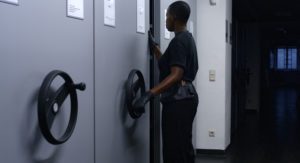
Belinda Kazeem-Kamiński, The Letter, 2019. Video (still). Photograph by the artist.
ML: In your work The Letter (2019), you present a scenario in which a group of “empaths” (people who experience empathy—feeling the feelings of others—acutely) are haunted by Yaarborley Domeï’s story. This 18-min speculative film investigates the power of the archives to haunt. Could you talk about how you have used the archive as a space to explore haunting in your text and films, which deal with the ghosts of an unfinished colonial past?
BKK: Remnants of an unfinished past pop up all the time. In Unearthing. In Conversation (2017), I hit a wall, so to speak, which I couldn’t get past, no matter what visual intervention into the archival material I tried. In the end, I realized that this is what I needed to stay with: the affect, and what calls to me when I encounter this material. This is what led to The Letter (2019). In The Letter a group of people, I call them empaths, breaks into an archive. They connect to stories, and objects by sensing, touching, and feeling. Whenever they open up drawers, we hear parts of the letter Yaarborley Domeï wrote. After they did what they came to do, they leave, and things in the archive start moving on their own.
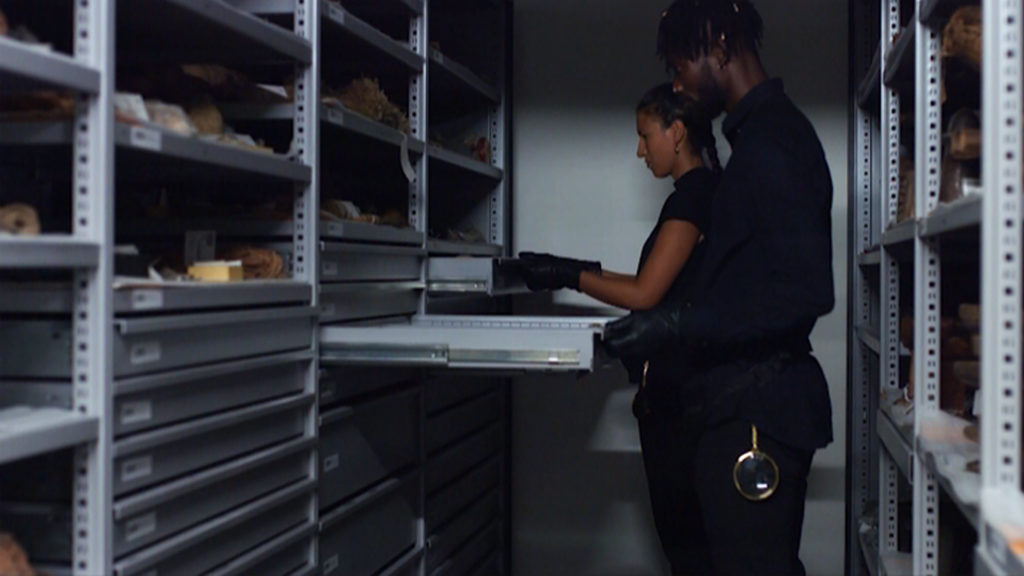
Belinda Kazeem-Kamiński, The Letter, 2019. Video (still). Photograph by the artist.
ML: You bring historically marginalized characters to life in your work by exploring how we look to the past. This reminds me of Avery Gordon’s Ghostly Matters: Haunting and the Sociological Imagination (2008),(Avery F Gordon, Ghostly Matters: Haunting and the Sociological Imagination (Minneapolis: University of Minnesota Press, 2008).) which deals with both the haunted past and the way we look at complex interactions of race, gender, and class. Does Gordon’s work relate to your approach to archives?
BKK: There are so many stories locked in archives, at the same time, they are such quiet spaces. How is this possible, shouldn’t there be a cacophony of sounds? I realized that whenever I was in an archive, I also tried to be super quiet, and I felt immediately called to perform this researcher mode, gloves, magnifying glass, the anticipation… That is when I thought: “If there was a group of people that could break into the archive, open up stuff, and thereby disrupt the archival order, these stories could leave this place and they could finally come out into the open. Then we would have to negotiate them in our everyday. This negotiation is what you see in my films and my textual interventions. Ghosts and hauntings are terms I used in Unearthing. In Conversation (2017), partly because I was indeed inspired by Avery Gordon’s concept of haunting, which she uses in order to point to violent happenings of the past that keep on popping up in the present. But after I finished Unearthing. In Conversation (2017), the term ghost didn’t sit right with me anymore because I didn’t consider these people from the past to be ghosts. Ghosts have this very “pop culture” connotation. We are taught to be afraid of them, but actually, I instead want to be in conversation with them. Working through this friction, I arrived at a text by German historian and cultural theorist, Nicola Lauré al-Samarai.(Nicola Lauré al-Samarai “Inspirited Topography: Hauntings Survivals and the Location of Experience in Black German Traditions of Knowledge and Culture,” in Remapping Black Germany: New Perspectives on Afro-German History, Politics, and Culture, ed. Sara Lennox (Boston: University of Massachusetts Press, 2016).) Here she uses the term Heimsuchung, she writes Heim-Suchung, the literal German translation of haunting—but it also could be translated as “looking for a home”, and this allows for a twist. Now, I think about these stories as stories that are looking for a home. They are asking: “How are you going to integrate us into your everyday existence?”

